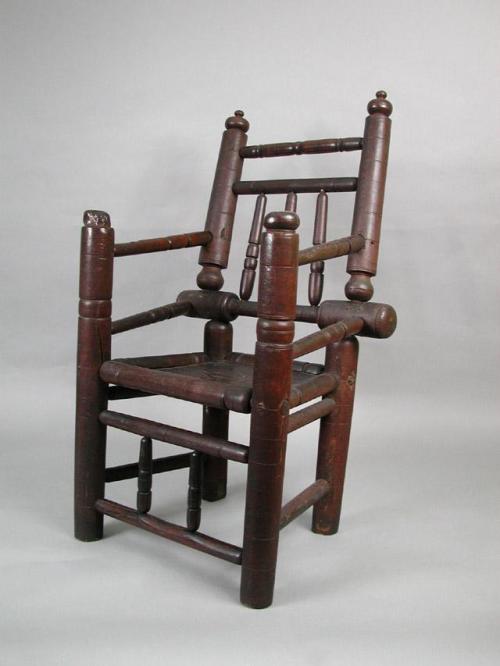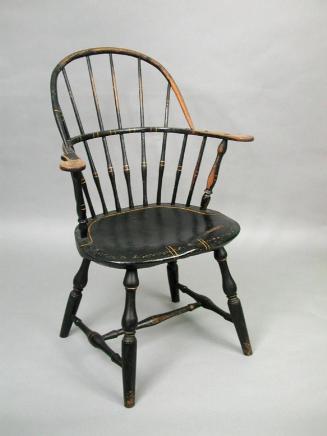Great Chair
Furniture MakerMade by
Unknown
Original OwnerPossibly originally owned by
Dr. Isaac Foote
(1672 - 1758)
Date1670-1700
MediumBlack ash, oak
DimensionsPrimary Dimensions (overall height x width x depth): 41 3/4 x 25 x 24 1/4in. (106 x 63.5 x 61.6cm)
ClassificationsFurniture
Credit LineBequest of Reverend Thomas Robbins
Object number1856.1.8
DescriptionBlack ash, turned, armchair with a board seat in the seventeenth-century style. The back of the chair is constructed of two thick posts; between the posts are two rails (top rail replaced) over three spindles (each side spindle is replaced). Each post and each spindle is joined to a horizontal rail that is located above the height of the seat. The posts are joined at an angle to the rail; they are slanted backward. Below the rail are the cylindrical back legs of the chair, each formed by a vertical cylindrical post. Each side of the chair has two rails, one each that extends forward the post and the rail to the vertical front leg posts. Above the trapezoidal seat, each front leg supports the arms, or rails, and has a ball-shaped handhold at the top. Each front leg is cylindrical and extends down to form a plain foot. The seat is constructed of a board that fits inside the front, side, and back seat rails. The front of the chair has two stretchers, separated by two spindles, below the seat. Each side of the chair has two turned stretchers.
Turned Decoration. Each post on the back of the chair has a small round knob over a compressed ball at the top, and a wide ovoid turning at the bottom. The top rail on the back of the chair (replaced) is turned with ring and cylindrical forms. The horizontal rail at the bottom of the back of the chair is turned with a narrow cylindrical section in the center, flanked by a wider cylinder that ends in a turned disc. The spindles on the back and front, and rails on each side, are turned with an ovoid form with a recessed ring in the center, flanked by gradually tapered sections. Each front leg is turned with a compressed ball-shaped handhold at the top (damaged) and a shallow compressed ball above the height of the seat. Each seat rail is turned with a long cylindrical section in the center which is flanked by an ovoid form. Each piece of the armchair has fine single or double incised lines circling the turned forms.
Condition: The top rail on the back of the seat is replaced. Each side spindle on the back of the chair is replaced. The center spindle was broken and repaired. Each handhold is well worn; each has suffered some areas of loss.
Design and Construction Details: The horizontal rails at the top back of the armchair are tenoned into the posts; the top rail is also pinned. Each spindle (two are replaced) is tenoned into the rails above and below. Each post is tenoned and pinned down into the rail at the bottom of the back; the back legs are tenoned and pinned into this same rail from below. The two rails at each side of the chair are tenoned and pinned into the posts and rail at the back and into the front legs. The seat rails are each tenoned through the back and front legs respectively. The trapezoidal seat is constructed of a single board that slides into grooves in the interior surface of each seat rail. The stretchers are tenoned in to the lower legs. The spindles at the front of the chair are tenoned into the stretchers above and below.
NotesOwner Note: Reverend Thomas Robbins of East Windsor, Connecticut, was the first librarian of the Connecticut Historical Society.Turned Decoration. Each post on the back of the chair has a small round knob over a compressed ball at the top, and a wide ovoid turning at the bottom. The top rail on the back of the chair (replaced) is turned with ring and cylindrical forms. The horizontal rail at the bottom of the back of the chair is turned with a narrow cylindrical section in the center, flanked by a wider cylinder that ends in a turned disc. The spindles on the back and front, and rails on each side, are turned with an ovoid form with a recessed ring in the center, flanked by gradually tapered sections. Each front leg is turned with a compressed ball-shaped handhold at the top (damaged) and a shallow compressed ball above the height of the seat. Each seat rail is turned with a long cylindrical section in the center which is flanked by an ovoid form. Each piece of the armchair has fine single or double incised lines circling the turned forms.
Condition: The top rail on the back of the seat is replaced. Each side spindle on the back of the chair is replaced. The center spindle was broken and repaired. Each handhold is well worn; each has suffered some areas of loss.
Design and Construction Details: The horizontal rails at the top back of the armchair are tenoned into the posts; the top rail is also pinned. Each spindle (two are replaced) is tenoned into the rails above and below. Each post is tenoned and pinned down into the rail at the bottom of the back; the back legs are tenoned and pinned into this same rail from below. The two rails at each side of the chair are tenoned and pinned into the posts and rail at the back and into the front legs. The seat rails are each tenoned through the back and front legs respectively. The trapezoidal seat is constructed of a single board that slides into grooves in the interior surface of each seat rail. The stretchers are tenoned in to the lower legs. The spindles at the front of the chair are tenoned into the stretchers above and below.
Research Note: Frances Gruber, Assistant Curator of American Wing at the Metropolitan Museum of Art examined this chair of 23 July 1998. In a letter dated 5 October 1971 (see Text Entries), she referenced a similar chair in the Metropolitan's collection. (Hudson 4/19/2006)
Status
On view













